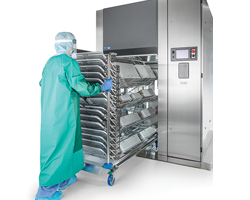Knowledge Center
May 20, 2021
Healthcare Sustainability: Solutions for Sustainability in Sterile Processing

Sterile Processing Departments (SPDs) play a critical role in positive patient outcomes and staff safety. Each day, sterile processing professionals are tasked with safely and efficiently processing surgical instruments and medical devices. But how sustainable is the sterile processing function?
To be sustainable requires an understanding of the broad and far-reaching definition of sustainability. According to the United Nations World Commission on Environment and Development, “sustainable development is development that meets the needs of the present without compromising the ability of future generations to meet their own needs.”1 Sustainability is more than protecting the planet. It focuses on ensuring environmental, social, and economic practices can be sustained for years to come by using methods, systems and materials that won’t deplete resources or harm natural cycles.
The SPD plays an important role in a hospital or healthcare facility’s sustainability strategy, affecting everything from staff and patient safety, water and energy conservation, and ethical practices. Every department should have a clear Mission and Vision Statement in line with their facility’s Mission and Vision Statement. A clear Mission and Vision statement is the beacon that guides the department on the path to successful outcomes and sustainability for the future.
STERIS uses four pillars to fulfill our commitment to creating a sustainable future for our Customers, our people, our shareholders, and the communities in which we work and live: Environmental Stewardship, People & Communities, Health & Safety, Ethical Business Practices.
This article will cover each area of sustainability as it relates to the sterile processing function and what SPDs can do to influence their healthcare facility’s sustainability strategy.
Environmental Stewardship

Environmental stewardship in sterile processing means creating a sustainable culture for staff through continuous improvement practices as well as using environmentally responsible products and processes where possible to lessen a hospital’s environmental impact. This may include:
- Improving organization within the department to reduce staff time looking for supplies
- Reducing operating costs and increasing water savings through efficient washer/disinfectors and steam sterilizers (autoclaves)
- Ensuring equipment is maintained and not past intended use life to eliminate the need for replacement
Environmental Factors of the Sterile Processing Department
A department that is clean, organized, has an updated appearance, and uses up-to-date equipment, promotes pride in ownership. This encourages staff to maintain the department and equipment sustaining a positive environment and increasing life expectancy of its equipment.
Reducing Cost and Waste in the SPD
Another factor in environmental sustainability in sterile processing is cost effectiveness and by default, waste management and reduction, of processes and products.
Processes
Sustainability should be a component of a department’s Quality Management System (QMS). Encouraging staff to identify waste and auditing the department on a routine basis will help in identifying waste such as water leaks, steam leaks, overfilled sinks, running water to rinse, among other examples.
Products & Services
An important focus on environmental stewardship in the SPD should be on products and services. For example, steam sterilizers that offer utility and water savings capabilities, short cycle times, and large tray capacities can help to maximize department productivity and save energy, costs, and utilities.
When evaluating supplies, consider whether they are disposable or reusable. Making the decision to purchase disposable items should involve the consideration of waste disposal as criteria in the final purchasing decision.
Services such as equipment maintenance also play a role in a department’s sustainability practices. Ensuring that your sterilization equipment is functioning properly and keeping it maintained is vital to the productivity of your facility. It also contributes to waste reduction: if a washer or steam sterilizer stops functioning properly due to lack of regularly scheduled maintenance, the hospital must purchase a new one. Additionally, if a sterilizer malfunctions, this can result in sterilization failures that require repackaging, and reprocessing of loads.
Balancing Compliance with Guidelines and Waste
An example of where disposable waste may be acceptable is where the task of maintaining reusables creates its own waste and risk of non-compliance to regulatory guidelines. For example, reusable brushes should be cleaned after each use and disinfected daily. Some facilities choose to use disposable brushes as it is more challenging to ensure all staff is performing the correct procedures and the cost of having enough reusable brushes to facilitate cleaning after each use may be less cost effective. Additionally, the time it takes for the added step of cleaning and disinfecting the brushes would add to contribute to a facility’s waste. Disposable brushes may result in less overall waste.
Safety
Meaningful safety performance promotes sustainable business practices, and safety is a vital part of working in the SPD. Effectively processing medical devices and instruments plays a vital role in influencing both positive patient outcomes and staff safety. SPDs should have access to a variety of safety resources – both internally and externally:
- Equipment and Product Manufacturer Resources – Safety resources for equipment, product, and service suppliers of a Sterile Processing Department may include safety data sheets (SDS), operator manuals, service manuals, and manufacturer training.
- Departmental Resources – Resources for safety within the department may include policy and procedure manuals, hazardous material’s management documents, bloodborne pathogen training, and safety committee resources.
Safety Tools
Tools that promote staff safety in the SPD include:
- Personal protective equipment (PPE)
- Eyewash stations
- Alarms and warnings
- Evacuation maps and training
- Ergonomic resources such as height-adjustable sinks and workstations and anti-fatigue mats
Employee Safety in the SPD
When it comes to safety in the SPD, staff must be aware of common risks and take the proper precautions to avoid them. SPD management should provide training and resources on avoiding these common safety risks. Examples include:
- Risk: Unprotected contact with biohazardous material
- Prevention: Ensure appropriate Personal Protective Equipment (PPE) is available and in the correct sizes. Additionally, ensure staff is trained in donning and doffing all appropriate PPE. Audit for compliance.
- Risk: Injuries from sharps (medical instruments that can cut or puncture skin)
- Prevention: Ways to prevent sharps-related injuries include completing a thorough and careful visual check of carts and trays before touching them, avoiding overloading trolleys, wearing puncture-resistant gloves, lifting only one tray at a time, and immediately reporting any damaged/defective trays or carts. Check for sharps such as needles and knife blades and know where the sharp instruments are prior to placing your hand in a tray.
- Risk: Exposure to chemicals
- Prevention: Follow chemical manufacturer’s instructions for use (IFUs) for appropriate Personal Protective Equipment (PPE), emergency procedures, spills, and handling of devices exposed to the chemical.
- Risk: Ergonomics (lifting or standing for prolonged periods of time)
- Prevention: Train staff on appropriate body mechanics, ensure tray weights are within recommended limits set by both the manufacturer of the cleaning and sterilization equipment and ANSI/AAMI Guidelines. Provide height-adjustable sinks and workstations.
- Risk: Burn injuries
- Prevention: Ensure there is appropriate Personal Protective Equipment (PPE) for the tasks at risk for burns. Consider purchasing equipment that has protective accessories to prevent heat-related injuries.
In the case of an employee exposure event, staff should follow facility policy and procedure.
Patient Safety in the SPD
The activities of the SPD – the appropriate cleaning, inspection, preparation, packaging, and sterilization of medical devices and surgical instruments – is the front line of ensuring positive patient outcomes. Thus, patient safety is top of mind for sterile processing professionals.
Developing a QMS that is proactive in preventing sterilization failures supports sustainability, as it reduces the waste of having to reprocess packages and re-sterilizing them due to sterilization failures. Wet packs, staining issues, chemical and biological indicator failures are preventable with a robust, multi-disciplinary team identifying the areas of risk and mitigating potential failures.
Competency
While a competency program is required by regulatory agencies for all staff members, this is also an important component of sustainability. Raising the bar for staff education, training, competency up to and including certification promotes pride in ownership: staff see themselves as the experts in their field and the department will reflect this mindset. Staff will understand the purpose of maintaining the environment, safety, equipment, and self-wellness and how that supports the ultimate goal of patient safety.
Ethical Practices
A less commonly recognized aspect of sustainability, ethical practices in the workplace – specifically, in the SPD – can impact the long-term success of a healthcare facility. While SPD professionals do not take a professional oath as some other professional healthcare groups, the review of the department’s Mission and Vision statement should provide the moral compass by which we perform our job daily. Sterile processing professionals – as with all professionals – should strive to always do what is right and best for the patient.
Quality Management
Having a QMS is an expectation of SPDs. ANSI/AAMI ST90 provides the roadmap to structure your departmental QMS. With quality audits, you can prevent waste by identifying areas for process improvement, identify process drift which allows for quick response before a negative outcome, and trains staff to observe and be aware of preventing waste of materials and time.
Conclusion
To be truly sustainable in the SPD requires a commitment across a variety of areas. For a healthcare facility, sustainability is a journey that evolves as regulations change and best practices are established.
Contributors

Michele McKinley,
LVN, CRCST, CIS, CHL, AGTS, ASQ CQM/OE, ASQ CQA, ASQ CSSYB
Senior Clinical Education Specialist, STERIS
Michele brings over 40 years of experience in healthcare with roles ranging from Operating Room Technician, Materials Management, and Site Manager for Outsourced Sterile Processing. In a previous role she has acted as a professional cleaning and sterilization consultant, advising on the processes for Sterile Processing the Operating Room and Endoscopy suites. She believes education is the path for ensuring quality, safe and competent patient care. She is an active member of IAHCSMM, AORN, SGNA, APIC, CASCA and ASQ. Michele holds a LVN in Nursing from the College of Canyons Valencia.
Related Resources
Article References
1 https://en.unesco.org/themes/education-sustainable-development/what-is-esd/sd


